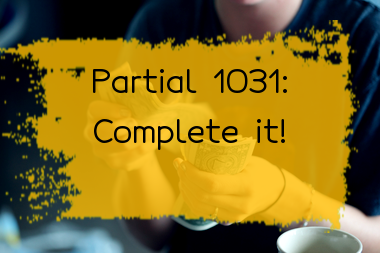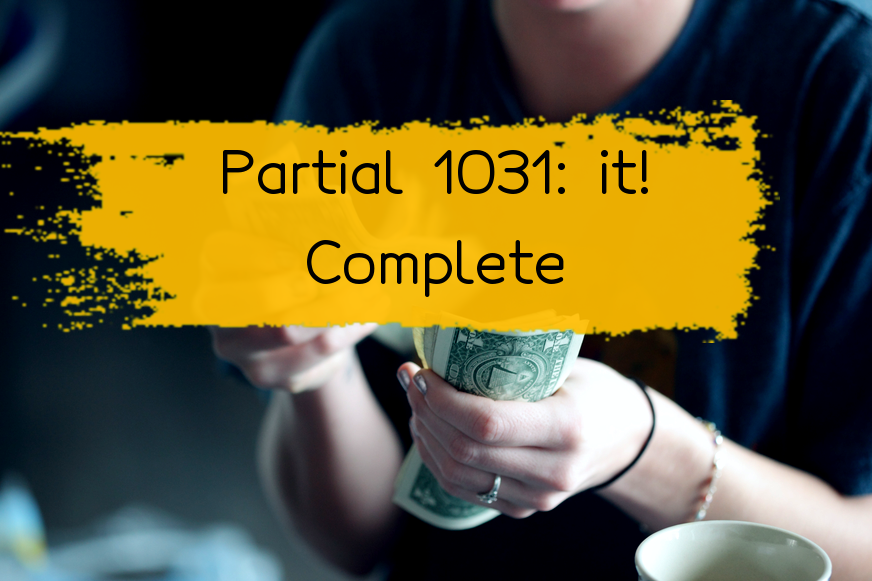A partial 1031 exchange is a type of 1031 exchange where only a portion of the proceeds from the sale of a property are reinvested in a like-kind property. This means that the seller of the relinquished property may choose to receive some of the proceeds in cash or invest a portion of the proceeds in a property that is not like-kind (such as stocks or bonds).
To complete a partial 1031 exchange, the seller must follow these steps:
- 1. Hire a qualified intermediary (QI): A QI is a third-party intermediary who facilitates the 1031 exchange transaction. The QI will hold the proceeds from the sale of the relinquished property until they are needed to purchase the replacement property.
- 2. Identify the replacement property: The seller must identify the replacement property within 45 days of selling the relinquished property. The seller can identify multiple replacement properties, but the total value of the properties identified must be equal to or greater than the value of the relinquished property.
- 3. Purchase the replacement property: The seller has 180 days from the date of the sale of the relinquished property to complete the purchase of the replacement property. The QI will use the proceeds from the sale of the relinquished property to purchase the replacement property.
- 4. Allocate the basis: The seller must determine how much of the basis (the cost of the relinquished property) will be allocated to the replacement property. This will determine how much of the gain from the sale of the relinquished property will be deferred.
- 5. Report the transaction on tax return: The seller must report the 1031 exchange on their tax return for the year in which the transaction took place.
It is important to note that a partial 1031 exchange can be more complicated than a full 1031 exchange, and may require the assistance of a tax professional or attorney. The seller should also consult with their QI to ensure that all of the requirements for a successful exchange are met.
A partial 1031 exchange is easy when you know how!
Based on research, here's an explanation regarding this topic:
A partial 1031 exchange can be more complicated than a complete 1031 exchange, but it can still be easy if you know what you're doing. In a partial 1031 exchange, you sell one property and use the proceeds to purchase one or more replacement properties. However, you might not spend all the proceeds from the sale of the original property on the replacement properties. This leaves you with "boot," the leftover cash from the sale. Any boot is taxable, so you'll want to minimize it as much as possible.
To do a partial 1031 exchange, you'll need to follow the guidelines set forth by the IRS. You must have a qualified intermediary (QI) to handle the exchange. The QI will be responsible for holding the proceeds from the sale of the original property and then using those proceeds to purchase the replacement properties. You'll need to provide the requisite information to your QI to ensure that the exchange is done correctly.
To minimize boot, you'll need to ensure that the value of the replacement properties is equal to or greater than the value of the property that you're selling. This will require careful planning and research to find the right properties to purchase.
Overall, a partial 1031 exchange can be easy if you work with an experienced QI and take the time to plan out the exchange. It's important to work with professionals who can help you navigate the complexities of the tax code and ensure that you're taking advantage of all of the benefits of a 1031 exchange.
What is a Partial 1031 Exchange?
A Partial 1031 Exchange is a type of real estate transaction that allows the taxpayer to defer paying capital gains taxes on a portion of the property sold, while still receiving cash proceeds from the sale. It is a legal tax strategy that is recognized by the Internal Revenue Code (IRC) Section 1031.
In a typical 1031 Exchange, the taxpayer sells a property and uses the entire proceeds to purchase a like-kind property within a specific limited time frame. This allows the taxpayer to defer paying capital gains taxes on the entire amount of the sale, as long as the property being purchased is of equal or greater value than the one sold.
A Partial 1031 Exchange, on the other hand, allows the taxpayer to identify one or more replacement properties that are worth less than the relinquished property. In this case, the taxpayer can receive cash proceeds from the sale of the property, while still deferring some of the taxes owed. The taxable amount is based on the difference between the sale price of the property and the cost of the replacement property.
For instance, if a taxpayer sells a property for $500,000 and identifies two replacement properties with a combined value of $400,000, they can still defer taxes on $100,000 of the sale proceeds. The taxpayer can choose to receive cash for the remaining $100,000 or use it to improve the replacement properties.
It's important to note that the taxpayer must follow strict IRS guidelines to qualify for a Partial 1031 Exchange. The identification of the replacement property or properties must be done within 45 days of the sale, and the transaction must be completed within 180 days.
In summary, a Partial 1031 Exchange is a useful way for real estate investors to defer taxes on a portion of their property sale while still receiving cash proceeds. However, it's crucial to seek professional advice from a qualified tax advisor or an experienced 1031 exchange facilitator to ensure that all legal requirements are met.
How Can You Do a Partial 1031 Exchange?
A partial 1031 exchange is a tax strategy that allows a taxpayer to exchange some, but not all, of their investment properties within a 1031 exchange. This is a useful strategy if the taxpayer wishes to cash out of some properties or consolidate their portfolio, while still deferring taxes on the exchange.
Here's how a partial 1031 exchange works:
- 1Identify the relinquished property: Identify the property you want to sell and relinquish for a partial exchange. This property must be an investment property or business property, not personal property.
- 2Engage a Qualified Intermediary (QI): Hire a QI to handle the exchange. The QI will hold the proceeds from the sale of the relinquished property until they can be used to purchase the replacement property, to ensure that the taxpayer does not have access to the funds and disqualify the exchange from a tax-deferral.
- 3Identify potential replacement properties: Identify potential replacement properties. Usually, the taxpayer has up to 45 days after the sale of the relinquished property has been completed to identify up to three replacement properties through a written document.
- 4Close the sale of relinquished property: Sell the relinquished property and have the sales proceeds sent to the QI and kept until the purchase of the replacement property.
- 5Use the proceeds to purchase replacement property: The taxpayer uses only a portion of the proceeds from the sale of the relinquished property to purchase a new property(s) for the exchange.
- 6Defer taxes: Defers the taxes on the portion of the proceeds from the sale of the relinquished property that was used to purchase a new property(s).
- 7Handle remaining funds: The taxpayer retains any remaining funds from the sale of the relinquished property, but must pay taxes on the remaining funds.
Partial 1031 exchanges can be complex, and it's important to work with a qualified intermediary and tax advisors to ensure that everything is done correctly and in compliance with IRS regulations.
Example: Reinvestment Purchase Less than Net Sale
When it comes to real estate investments, one of the common strategies used by investors is to reinvest the profits generated from the sale of a property to purchase another one. This process is known as reinvestment purchase.
The net sale, on the other hand, refers to the amount of money that an investor receives after deducting any expenses such as closing costs and brokerage fees from the sale of a property.
Therefore, when the reinvestment purchase is less than the net sale, it means that the investor has not reinvested the entire amount generated from the sale of the property. In other words, they have some leftover cash from the sale.
There could be several reasons why an investor may choose not to reinvest the entire amount. For instance, they may want to keep some cash for emergencies or to invest in other opportunities. Alternatively, they may not have found a suitable property to invest in and therefore decided to hold onto the cash.
It's important to note that while reinvesting profits can be a beneficial strategy for real estate investors, it's not always necessary or appropriate in every situation. Each investment opportunity should be evaluated based on its potential returns, risks, and suitability for the investor's overall investment goals and strategy.
Tax Consequences of a Partial 1031 Exchange
In a partial 1031 exchange, a taxpayer sells a property and uses the proceeds to buy one or more replacement properties. However, the taxpayer doesnt use all the sale proceeds to buy the new property. Instead, the excess funds are kept by the seller as cash and subject to tax.
For example, if the taxpayer sells their real estate property for $1 million and buys a new property for $750,000, they have $250,000 in cash that is taxable. The $750,000 that was used to purchase the new property qualifies for a 1031 exchange.
The tax consequences of a partial 1031 exchange are straightforward. The amount of cash received by the seller is considered to be a gain and is subject to taxes. The taxable portion of a partial 1031 exchange is calculated by subtracting the cost of the replacement property from the proceeds of the original sale. This difference is considered to be the sellers gain on the sale.
Additionally, the seller may be liable for other taxes, such as state and local income taxes, capital gains taxes, and depreciation recapture taxes.
In summary, a partial 1031 exchange allows taxpayers to defer taxes on the portion of the proceeds used to purchase new properties. However, any proceeds not used to purchase replacement properties are subject to taxation. Taxpayers should consult with their tax advisors and legal professionals for more detailed information on partial 1031 exchanges.
Just one more thing: if you liked the article, please like us on social media and share this article with friends.



